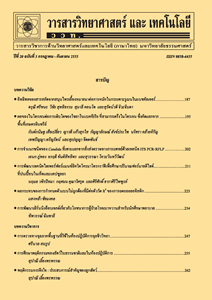Evaluation of Hepatitis C Virus Infection Analysis by Anti-HCV and HCV Core Antigen Assays
Main Article Content
Abstract
Anti-HCV test is wildly used for screening of hepatitis C virus infection. The signal-to-cutoff (S/CO) ratio can be used to interpret hepatitis C virus infection; above a certain S/CO ratio value. However, it is likely to be a false positive. The purpose of this study was to determine the optimal anti-HCV signal-to-cutoff (S/CO) ratio and to evaluate the agreement between the HCV core Ag and HCV RNA. The total of 169 leftover serum/plasma samples from anti-HCV screening (chemiluminescence microparticle immunoassay, CMIA) were obtained from Thammasat University hospital. These samples were tested for HCV core Ag and HCV RNA (real-time RT-PCR). A receiver operating characteristic (ROC) curve was applied to determine the optimal signal-to-cutoff (S/CO) ratio by using HCV RNA for defending hepatitis C virus infection. Cohen's kappa coefficient was used to evaluate the agreement between the HCV core Ag and HCV RNA. The ROC curves analysis showed that the cutoff point of anti-HCV S/CO ratio was 5.4 (sensitivity 100 % and specificity 93.3 %). Both of HCV core Ag and HCV RNA are excellent agreement (kappa =0.988, p < 0.001). In conclusion, the optimal anti-HCV S/CO ratio value is appropriate for screening of hepatitis C virus infection. There is an excellent agreement between HCV core Ag and HCV RNA as a standard method. Therefore, HCV core Ag is a valid and reliable method for confirmation of hepatitis C virus infection
Article Details
References
World Health Organization, Hepatitis C, Available Source: https://www.who.int/news-room/fact-sheets/detail/hepatitis-c, March 15, 2021.
Sy, T. and Jamal, M.M., 2006, Epidemiology of hepatitis C virus (HCV) infection, Int. J. Med. Sci. 3: 41-46.
Petruzziello, A., Marigliano, S., Loquercio, G., Cozzolino, A. and Cacciapuoti, C., 2016, Global epidemiology of hepatitis C virus infection: An up-date of the distribution and circulation of hepatitis C virus genotypes, World J. Gastroenterol. 22: 7824-7840.
Jiamsiri, S., 2018, Hepatitis C Virus Disease, Available Source: https://apps.doe.moph.go.th/boe/viewddcw.php, Decamber 22, 2018. (in Thai)
Moorman, A.C., Drobenuic, J. and Kamili, S., 2017, Prevalence of false-positive hepatitis C antibody results, National Health and Nutrition Examination Study (NHANES) 2007-2012, J. Clin. Virol. 89: 1-4.
Pereira, F.M., Zarife, M.A., Reis, E. and Reis, M.G., 2014, Indeterminate RIBA results were associated with the absence of hepatitis C virus RNA (HCV-RNA) in blood donors, Revista da Sociedade Brasileira de Medicina Tropical 47: 12-17.
Bossi, V. and Galli, C., 2004, Quantitative signal of anti-HCV by an automated assay predicts viremia in a population at high prevalence of hepatitis C virus infection, J. Clin. Virol. 30: 45-49.
Majid, A.M. and Gretch, D.R., 2002, Current and future hepatitis C virus diagnostic testing: problems and advancements, Microbes Infect. 4: 1227-1236.
Committee, T., 2018, Thailand practice guideline for management of chronic hepatitis C 2018, Thai J. Hepatol. 1(3): 50-60. (in Thai)
Laboratories A, Architect system Anti-HCV October 2009, Available Source: https://www.ilexmedical.com/files/PDF/AntiHCV_ARC.pdf, March 15, 2021.
Kesli, R., Polat, H., Terzi, Y., Kurtoglu, M. and Uyar, Y., 2011, Comparison of a newly developed automated and quantitative hepatitis C virus (HCV) core antigen test with the HCV RNA assay for clinical usefulness in confirming anti-HCV results, J. Clin. Microbiol. 49: 4089-4093.
Couroucé, A., Marrec, N., Bouchardeau, F., Razer, A., Maniez, M., Laperche, S. and Simon, N, 2000, Efficacy of HCV core antigen detection during the presser conversion period transfusion, Transfusion 40: 1198-1202.
European Association for the Study of the Liver, EASL Recommendations on treatment of hepatitis C 2018, 2018, J. Hepatol. 69: 461-511.
Kim, H.S., 2009, Anti-HCV signal-to-cutoff ratio in predicting hepatitis C viremia, Korean J. Int. Med. 24: 299-301.
Seo, Y.S., Jung, E.S., Kim, J.H., Jung, Y.K., Kim, J.H., An, H., Yim, H.J., Yeon, J.E., Byun, K.S., Kim, C.D., Ryu, S.H. and Um, S.H., 2009, Significance of anti-HCV signal-to-cutoff ratio in predicting hepatitis C viremia, Korean J. Int. Med. 24: 302-308.
Moretti, M., Pieretti, B., Masucci, A., Sisti, D., Rocchi, M. and Delprete, E., 2012, Role of signal-to-cutoff ratios in hepatitis C virus antibody detection, Clin. Vaccine Immunol. 19: 1329-1331.
López-Fabal, M., Pérez-Rivilla, A. and Gómez-Garcés, J.L., 2018, Evaluation of sera with a low signal to cut-off ratio using two chemiluminescent assays for detecting Hepatitis C Virus, and their correlation with the detection of viral RNA, Enferm. Infecc. Microbiol. Clin. 36: 222-224.
Yokosuka, O., Kawai, S., Suzuki, Y., Fukai, K., Imazeki, F., Kanda, T., Saisho, H., 2005, Evaluation of clinical usefulness of second-generation HCV core antigen assay: comparison with COBAS AMPLICOR HCV MONITOR assay version 2.0, Liver Int. 25: 1136-1141.
Tanaka, E., Kiyosawa, K., Matsumoto, A., Kashiwakuma, T., Hasegawa, A., Mori, H., Yanagihara, O. and Ohta, Y., 1996, Serum levels of hepatitis C virus core protein in patients with chronic hepatitis C treated with interferon alfa, Hepatology 23: 1330-1333.
Tedder, R.S., Tuke, P., Wallis, N., Wright, M., Nicholson, L. and Grant, P.R., 2013, Therapy-induced clearance of HCV core antigen from plasma predicts an end of treatment viral response, J. Viral. Hepat. 20: 65-71.
Tillmann, H.L., 2014, Hepatitis C virus core antigen testing: Role in diagnosis, disease monitoring and treatment, World J. Gastroenterol. 20: 6701-6706.
Song, D., Kang, J.E., Kim, S.Y., Hwang, S.H., Kim, H.H., Lee, E.Y. and Son, H.C., 2010, Evaluation of ARCHITECT HCV core antigen assay, Korean J. Lab. Med. 30: 654-659.
Park, Y., Lee, J.H., Kim, B.S., Kim, D.Y., Han, K.H. and Kim, H.S., 2010, New automated hepatitis C virus (HCV) core antigen assay as an alternative to real-time PCR for HCV RNA quantification, J. Clin. Microbiol. 48: 2253-2256.
Ross, R.S., Viazov, S., Salloum, S., Hilgard, P., Gerken, G. and Roggendorf, M., 2010, Analytical performance characteristics and clinical utility of a novel assay for total hepatitis C virus core antigen quantification, J. Clin. Microbiol. 48: 1161-1168.


